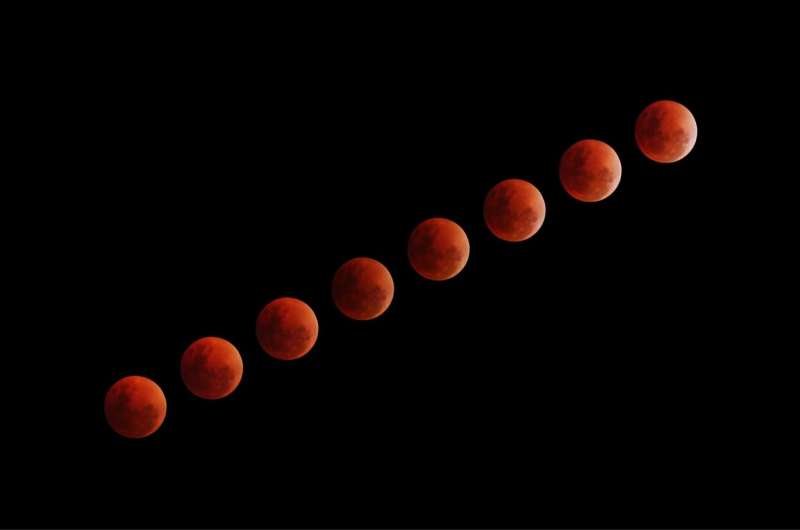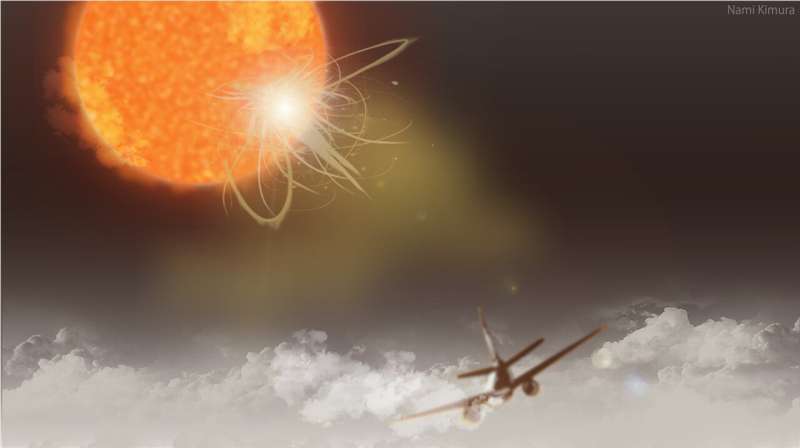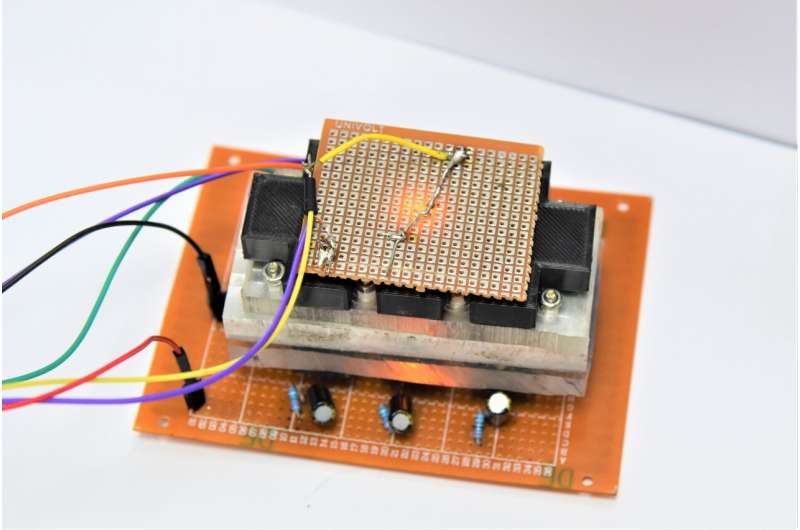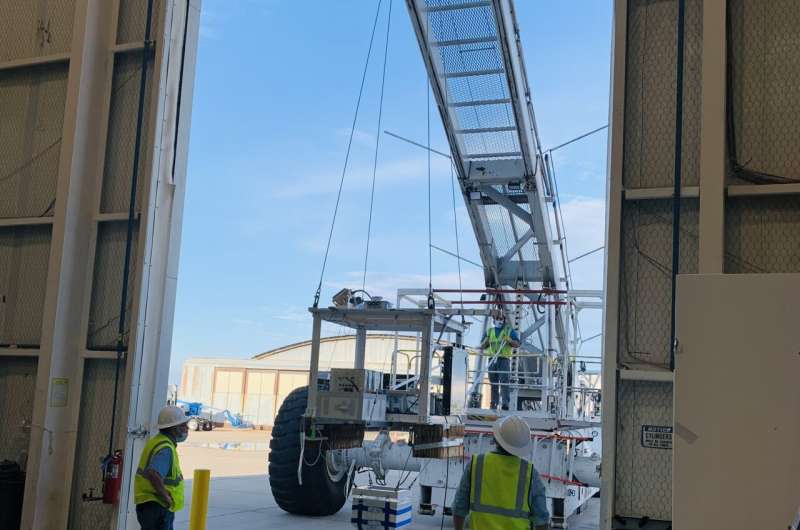
Copernical Team
Buttes on Mars may serve as radiation shelters

Mars has a "bad reputation" for its high exposure to radiation and it has neither a magnetic field nor a thick atmosphere to shelter its surface from high energy particles from outer space.
In a study published in Geophysical Research Letters, Guo Jingnan from University of Science and Technology of China (USTC) of the Chinese Academy of Sciences, and international collaborators, analyzed the data from the Radiation Assessment Detector (RAD) on the Curiosity rover, and proposed a possible way to mitigate radiation on Mars.
The Curiosity rover launched in November, 2011 and landed on Mars in August, 2012. It was dedicated to searching for the elements of life on Mars. In September, 2016, Curiosity parked close to a butte and detected a reduction in radiation dose, and when Curiosity traversed far from the butte, the dose came back to normal. The researchers attributed this change in radiation dose to topographical variations.
They then plotted the panoramic sky visibility map of RAD for further investigation. They found that about 20% of the sky was blocked when Curiosity rover was near the butte, and the number was less than 10% before getting close to the butte, which suggested that surrounded buttes did shield a portion of radiation.
Icarus can fly high and save on wax too

"Don't fly too close to the sun," said Daedalus to Icarus. Flying too high would melt the wax in his wings, while going too low would cause the sea's moisture to create drag.
Commercial flight crews do not usually appear in Greek mythology, but they have to work with the occupational hazard of aviation radiation exposure. Aviation guidelines aim to mitigate the effects of radiation, mainly caused by galactic cosmic rays and solar energetic particles, or SEP. The fluxes in the former are stable and predictable: dose rates are no higher than 10 µSv/h at the normal flight altitude of 12 km.
But in the case of SEP, does the frequency of detected solar flares justify the costs of countermeasures? Current mitigation procedures instruct planes to lower altitude or change or cancel flight paths altogether, significantly raising expenses.
German government, industry back North Sea spaceport plan

The German government said Monday it supports plans for a North Sea spaceport that would be used to launch small satellites into space from Europe.
Economy Minister Peter Altmaier said the government would act as an "anchor customer" for the floating launch site off the German coast.
"We want to strengthen the national space program," he said at an event marking the signing of cooperation agreements between the German Offshore Spaceport Alliance and four European rocket manufacturers—two from Germany, one from the Netherlands and one from Britain.
Siegfried Russwurm, head of the Germany industry association BDI, said a spaceport in the North Sea would make it easier to launch satellites into polar and sun-synchronous orbits.
There are more than 20 spaceports around the world already, but European space companies currently rely mostly on launches from Russia's site in Kazakhstan, French Guiana in South America and from the United States.
Explore further
© 2021 The Associated Press. All rights reserved. This material may not be published, broadcast, rewritten or redistributed without permission.
Modular device for extra-terrestrial experiments

Researchers at the Indian Institute of Science (IISc) and Indian Space Research Organisation (ISRO) have developed a modular, self-contained device to cultivate microorganisms, which could enable scientists to carry out biological experiments in outer space.
In a study published in Acta Astronautica, the team showed how the device can be used to activate and track the growth of a bacterium called Sporosarcina pasteurii over several days, with minimal human involvement.
Understanding how such microbes behave in extreme environments could provide valuable insights for human space missions such as "Gaganyaan," India's first crewed spacecraft, set for launch in 2022. In recent years, scientists have been increasingly exploring the use of lab-on-chip platform that combine many analyses into a single integrated chip for such experiments. But there are additional challenges to designing such platforms for outer space, when compared to the lab.
"It has to be completely self-contained," points out Koushik Viswanathan, Assistant Professor in the Department of Mechanical Engineering and a senior author of the study. "Besides, you can't simply expect the same operating conditions as you would in a normal laboratory setting … and you can't have something that guzzles 500W, for example.
Science, student payloads fly aboard NASA's scientific balloons during fall campaign

NASA's Scientific Balloon Program's 2021 fall campaign is now underway in Fort Sumner, New Mexico, launching the first three of eight missions in August.
The missions planned for this campaign include an annual student experiment, three missions from NASA's Jet Propulsion Laboratory (JPL), and technology demonstrations for NASA's Columbia Scientific Balloon Facility.
The campaign window opened in mid-August and will run through mid-October.
"After a successful spring campaign, we hope to continue that success into our fall campaign," said Debbie Fairbrother, Scientific Balloon Program Office chief at NASA's Wallops Flight Facility in Virginia. "These flights continue to not only be important to our university and NASA partners, but to the next generation who get a hands-on experience building and flying their experiments aboard a real science platform.
Astronaut geology bound for the Moon

Finding and collecting the best lunar samples will be a major task for the next astronauts on the Moon. ESA’s Pangaea training campaign launches today to equip astronauts with a geologist’s eye on the Moon – humanity’s next space destination to help us understand more about our Solar System.
New wave of electron research
 While studying the behavior of electrons in iron-based superconducting materials, researchers at the University of Tokyo observed a strange signal relating to the way electrons are arranged. The signal implies a new arrangement of electrons the researchers call a nematicity wave, and they hope to collaborate with theoretical physicists to better understand it. The nematicity wave could help rese
While studying the behavior of electrons in iron-based superconducting materials, researchers at the University of Tokyo observed a strange signal relating to the way electrons are arranged. The signal implies a new arrangement of electrons the researchers call a nematicity wave, and they hope to collaborate with theoretical physicists to better understand it. The nematicity wave could help rese Humanoid robots catch the eye of humans when interacting
 Gaze is an extremely powerful and important signal during human-human communication and interaction, conveying intentions and informing about other's decisions. What happens when a robot and a human interact looking at each other? Researchers at IIT-Istituto Italiano di Tecnologia (Italian Institute of Technology) investigated whether a humanoid robot's gaze influences the way people reason in a
Gaze is an extremely powerful and important signal during human-human communication and interaction, conveying intentions and informing about other's decisions. What happens when a robot and a human interact looking at each other? Researchers at IIT-Istituto Italiano di Tecnologia (Italian Institute of Technology) investigated whether a humanoid robot's gaze influences the way people reason in a Artillerymen must be ready to operate in space degraded, denied environments
 The U.S. Space Command provides capability to warfighters, including those in precision fires; leaders involved in fires should also be prepared - and prepare soldiers - to operate without that space capability in case the environment is denied or degraded, the Spacecom commander said.
Spacecom provides, among other things, position navigation and timing, satellite communications, intellig
The U.S. Space Command provides capability to warfighters, including those in precision fires; leaders involved in fires should also be prepared - and prepare soldiers - to operate without that space capability in case the environment is denied or degraded, the Spacecom commander said.
Spacecom provides, among other things, position navigation and timing, satellite communications, intellig Ingenuity Mars Helicopter set to fly lower for detailed surface imaging
 Following Flight 12's scouting images of "South Seitah," which were the most valuable Ingenuity has taken to date, we are taking Winston's advice for Ingenuity's 13th flight. We will again be venturing across into Seitah to scout an area of outcrops glimpsed in Flight 12 imagery - but we're taking these new pictures while looking back, pointing in the opposite direction.
Taking place no ea
Following Flight 12's scouting images of "South Seitah," which were the most valuable Ingenuity has taken to date, we are taking Winston's advice for Ingenuity's 13th flight. We will again be venturing across into Seitah to scout an area of outcrops glimpsed in Flight 12 imagery - but we're taking these new pictures while looking back, pointing in the opposite direction.
Taking place no ea 
